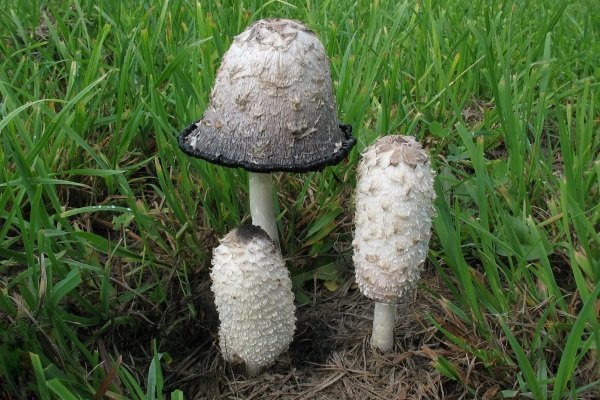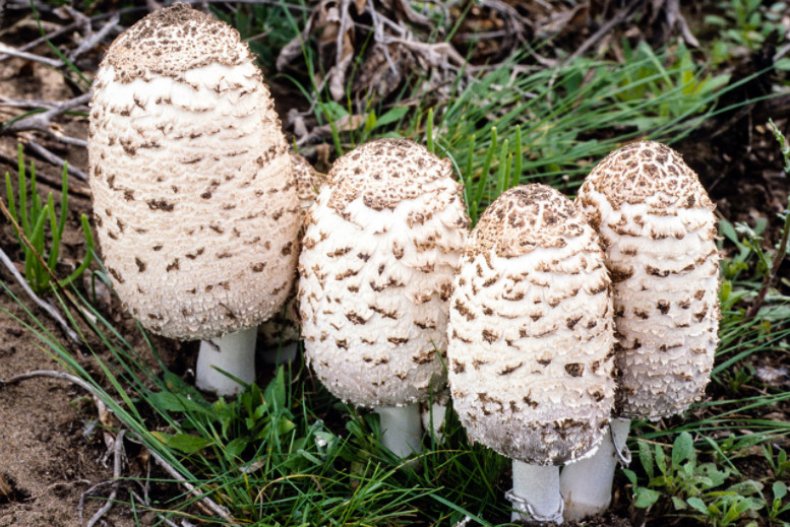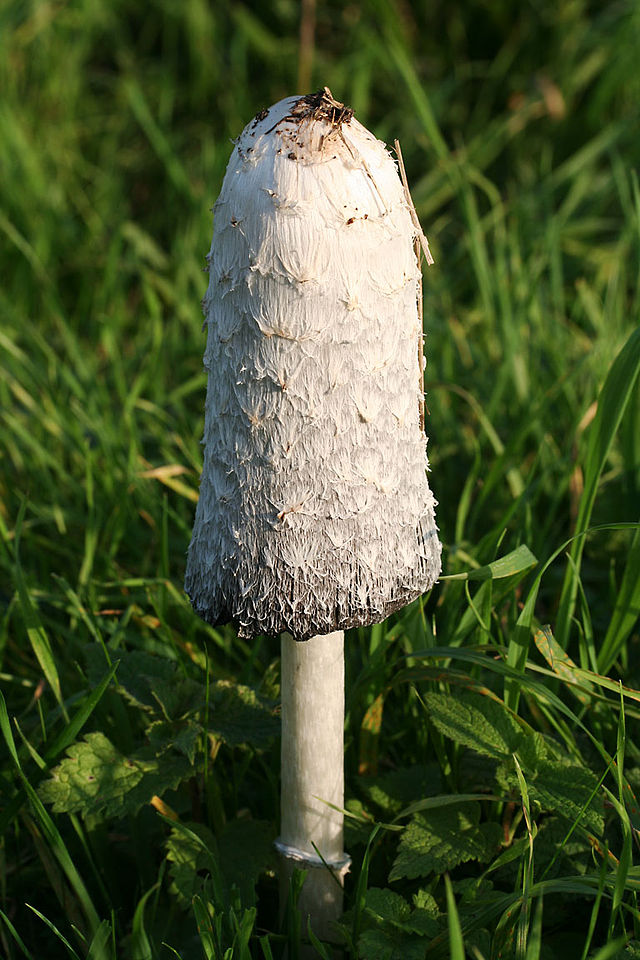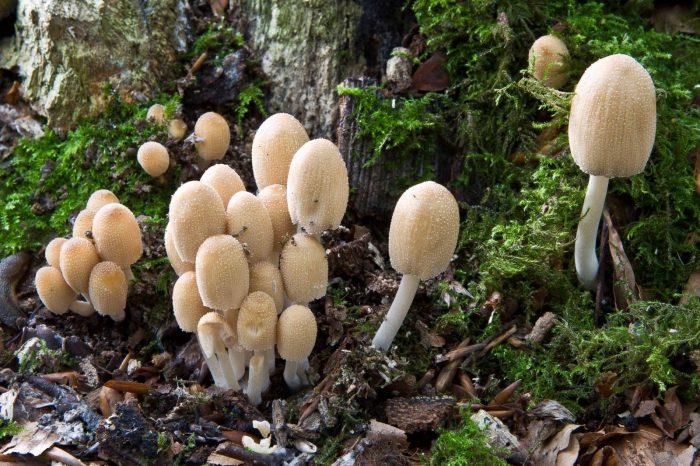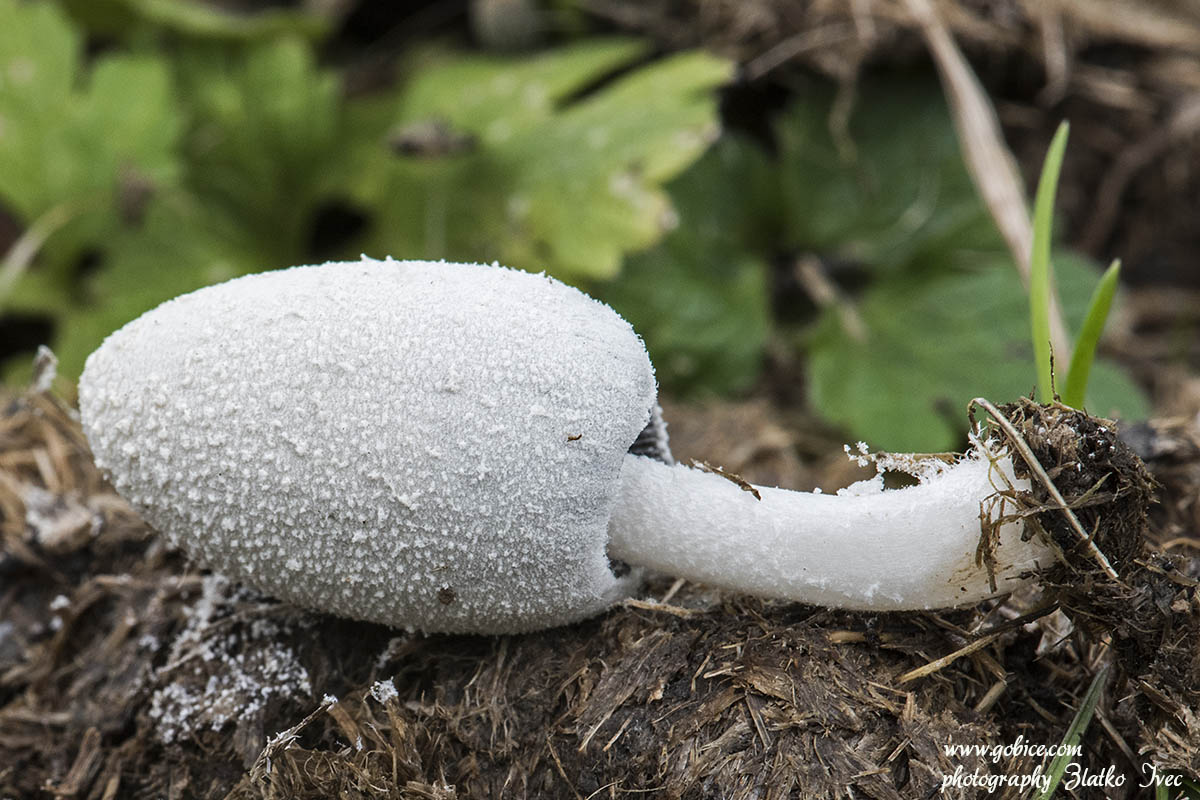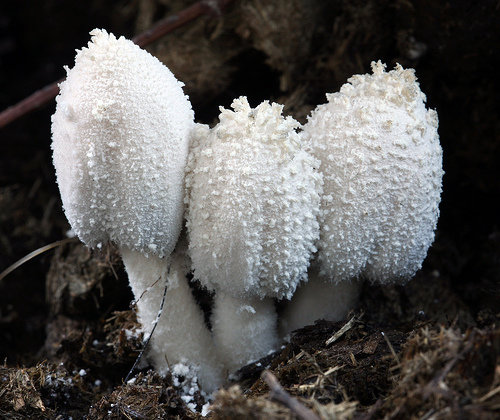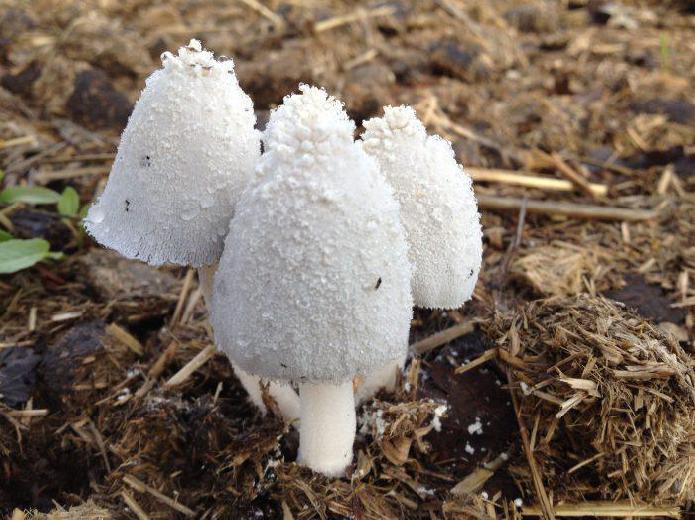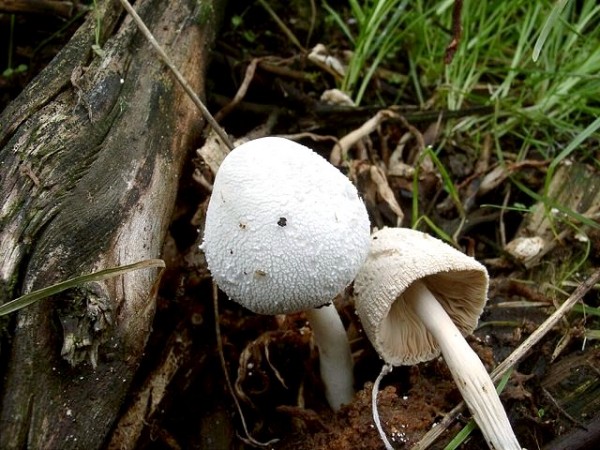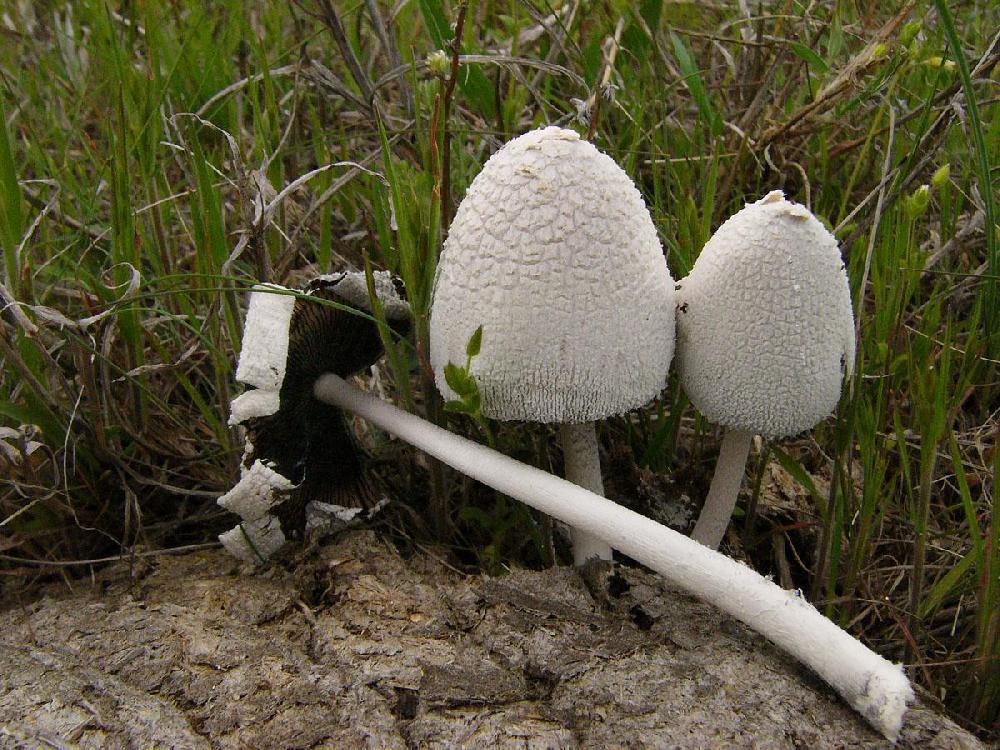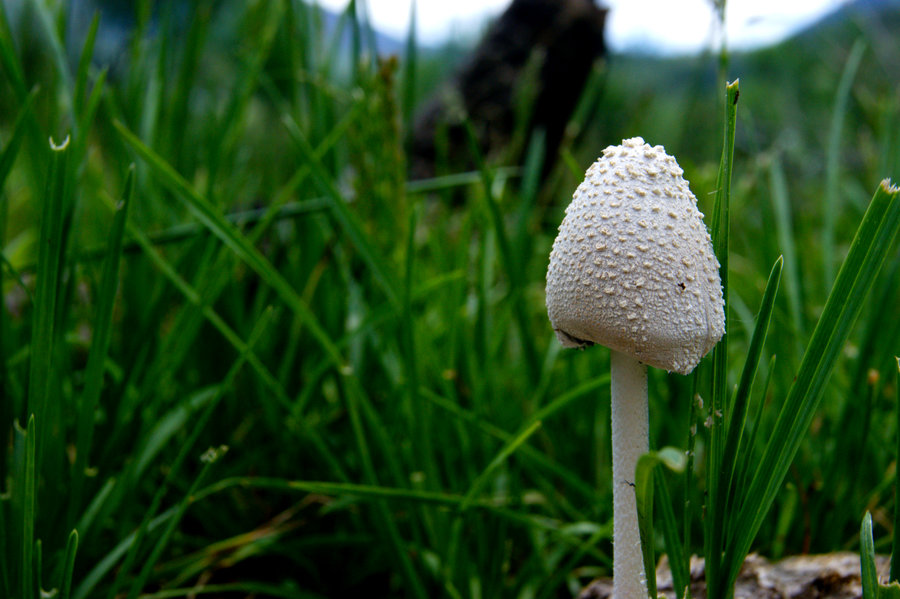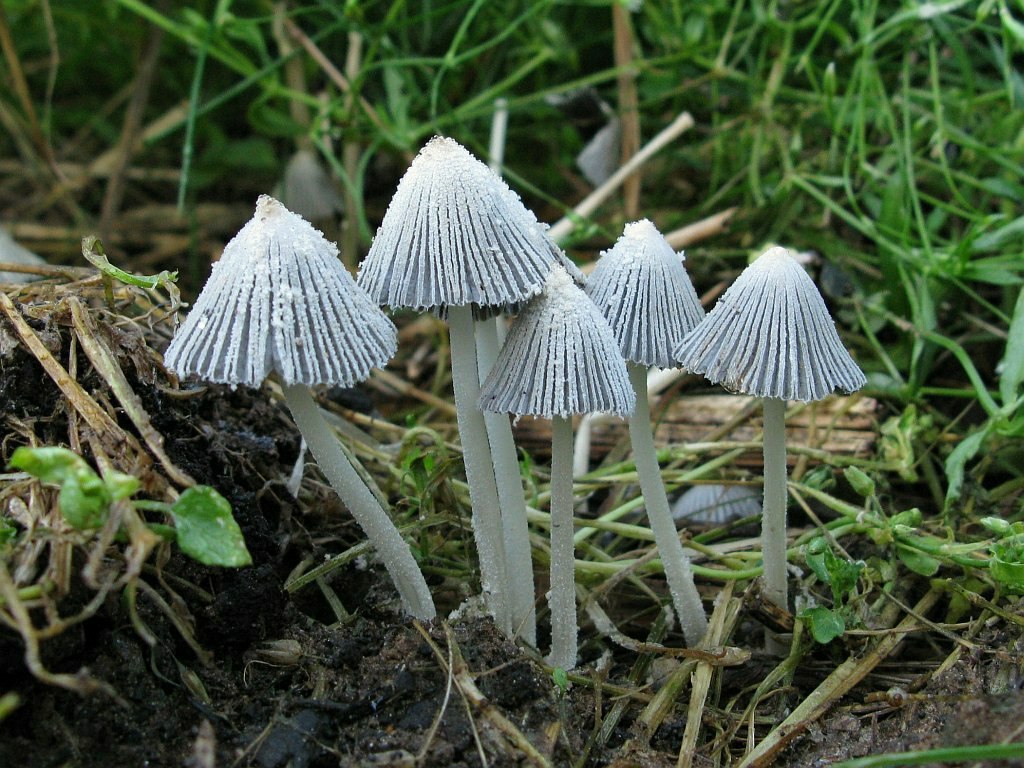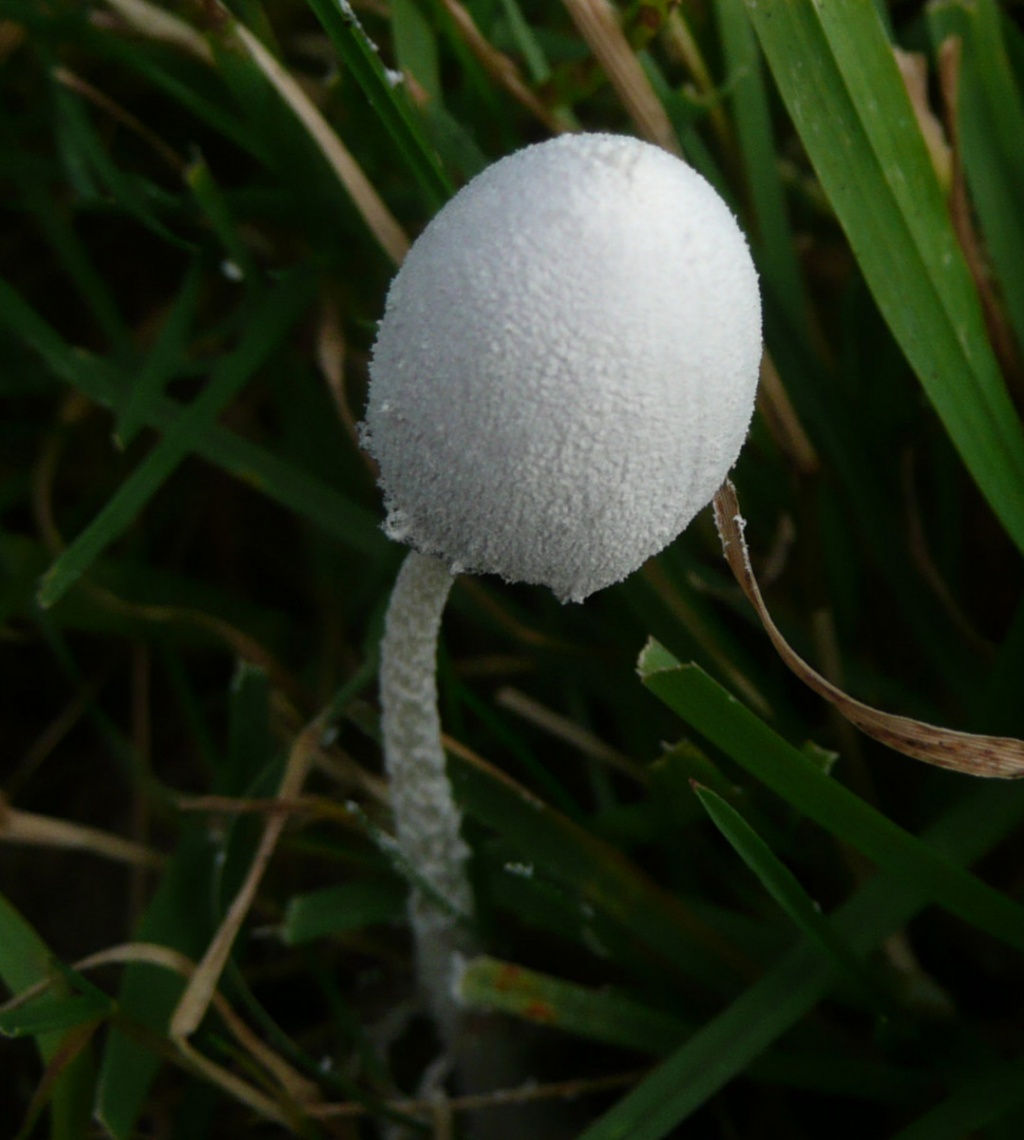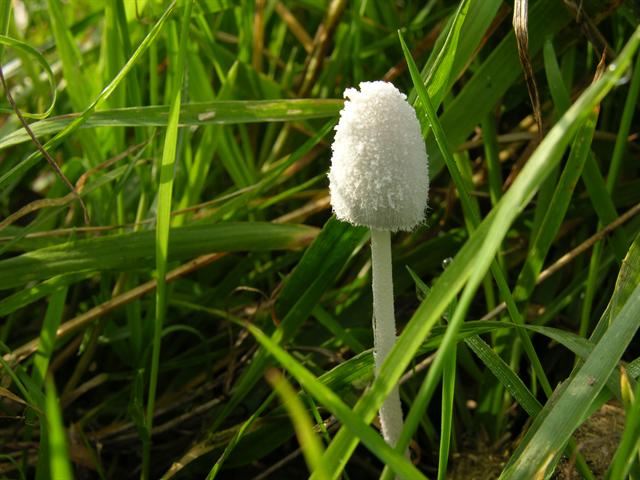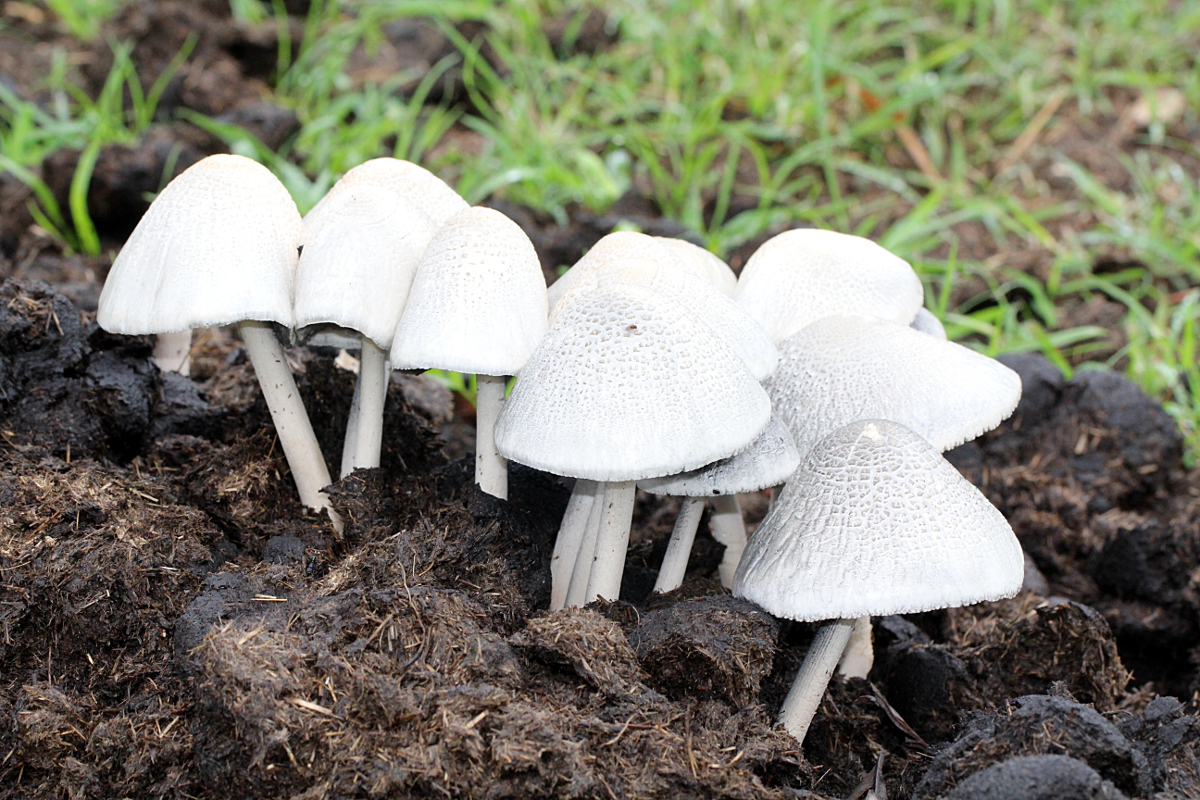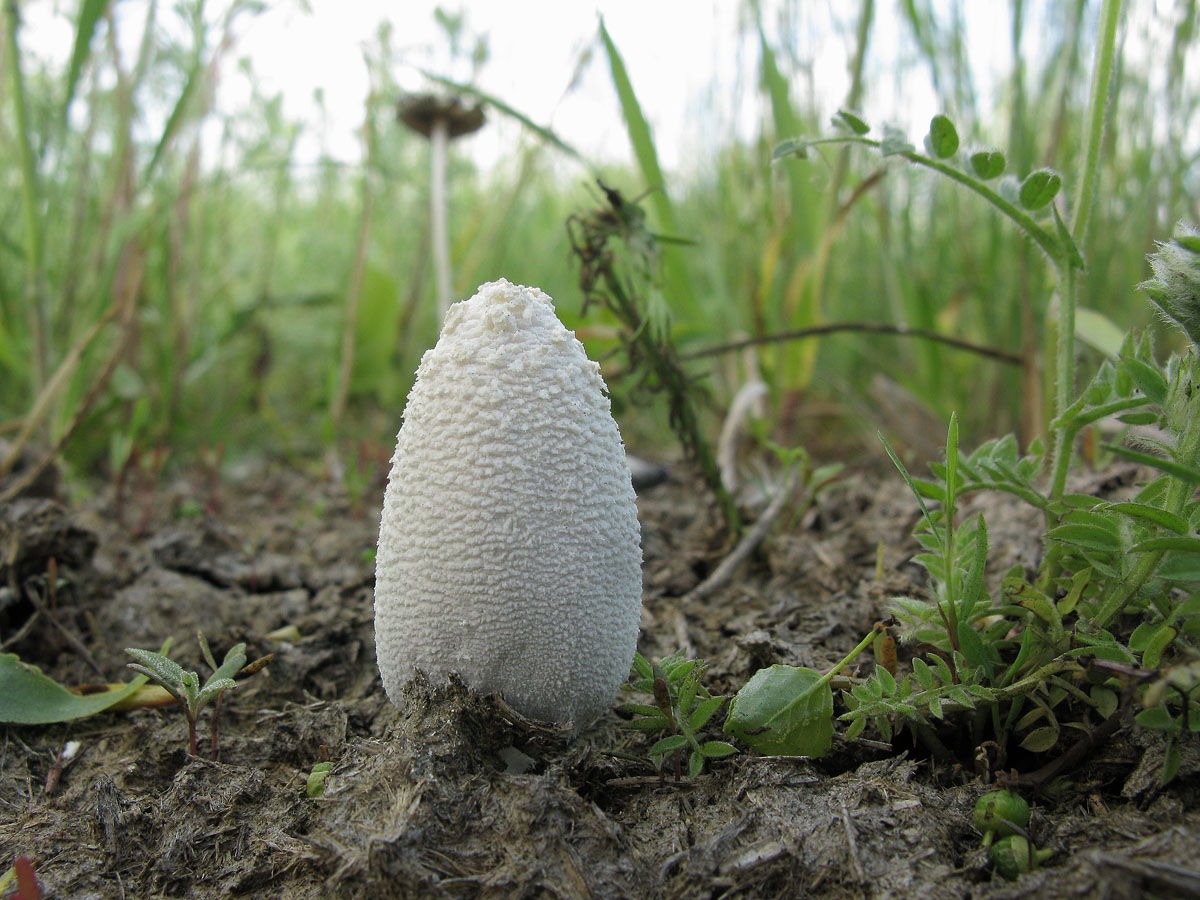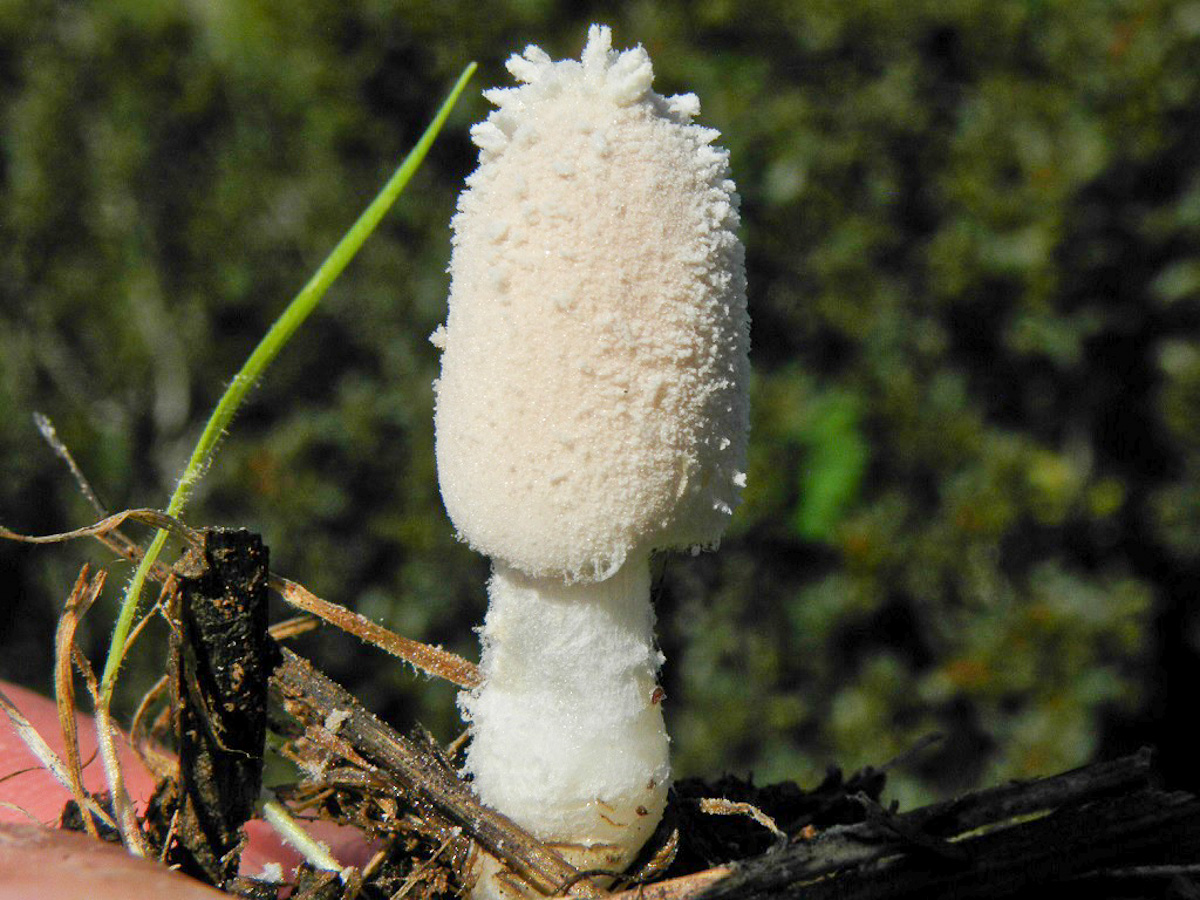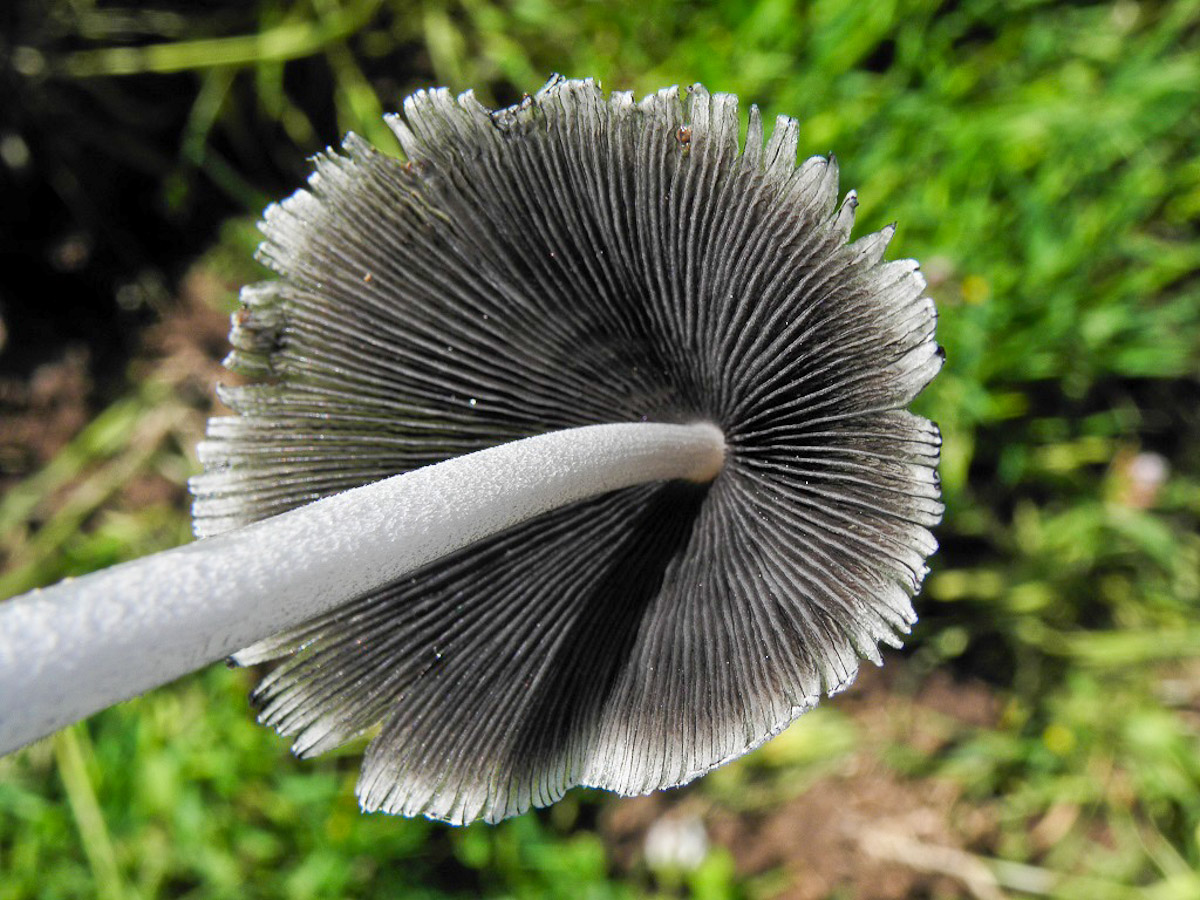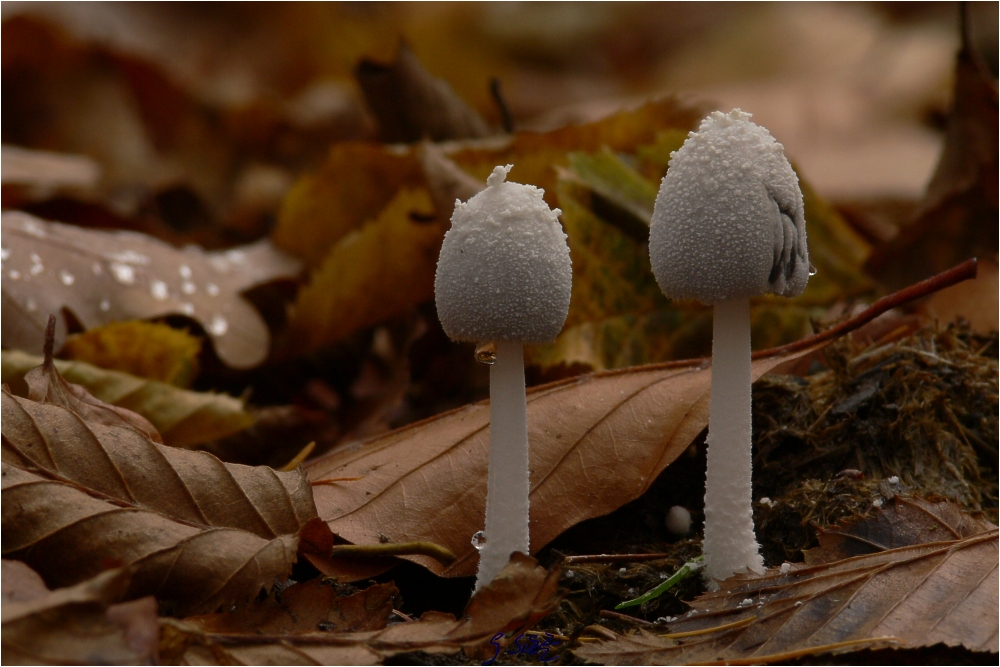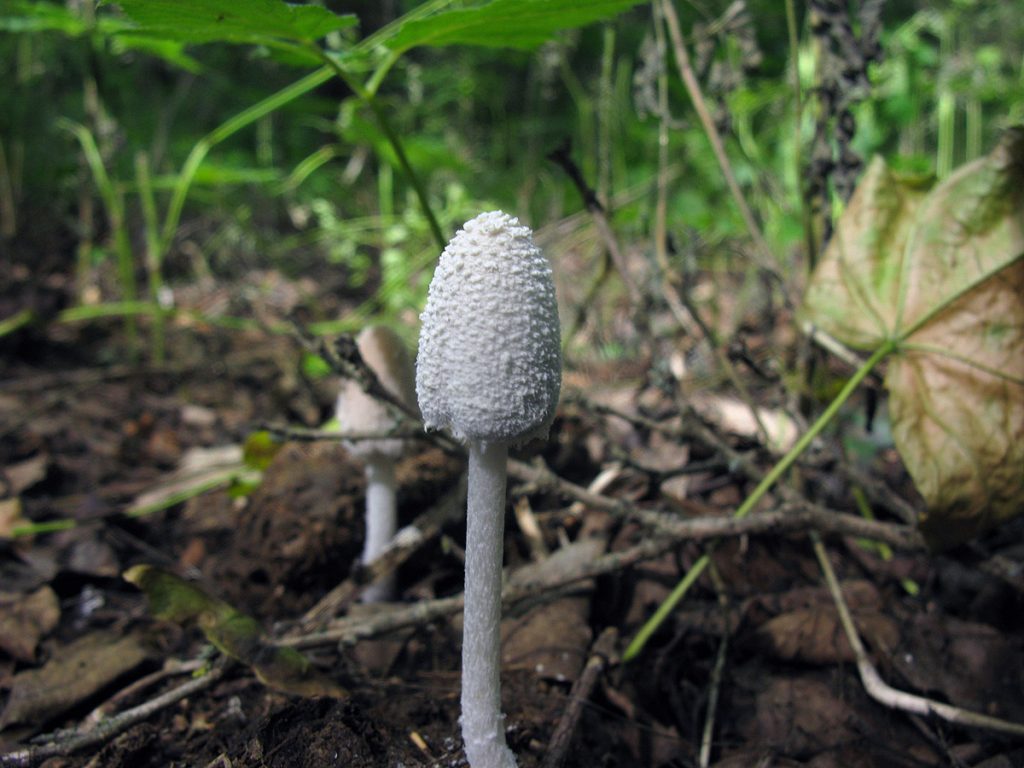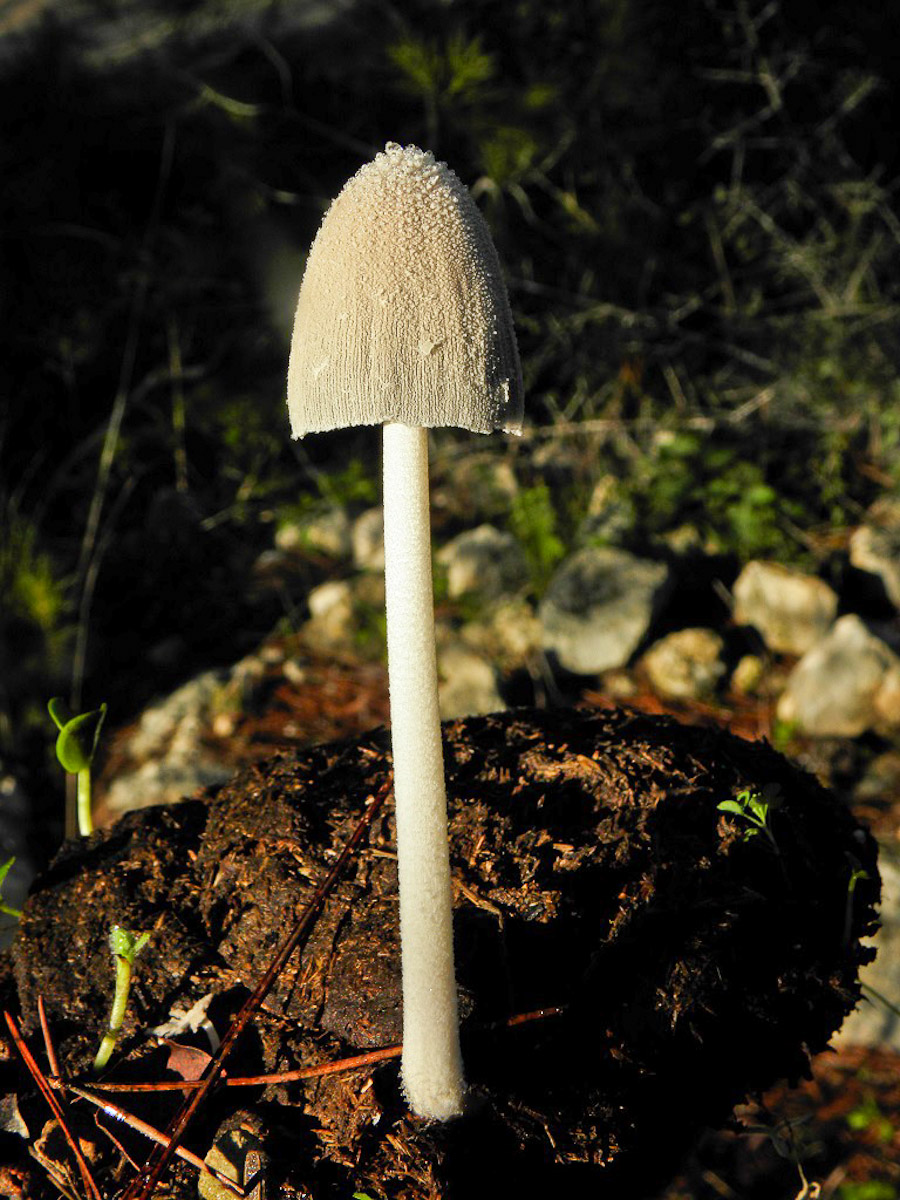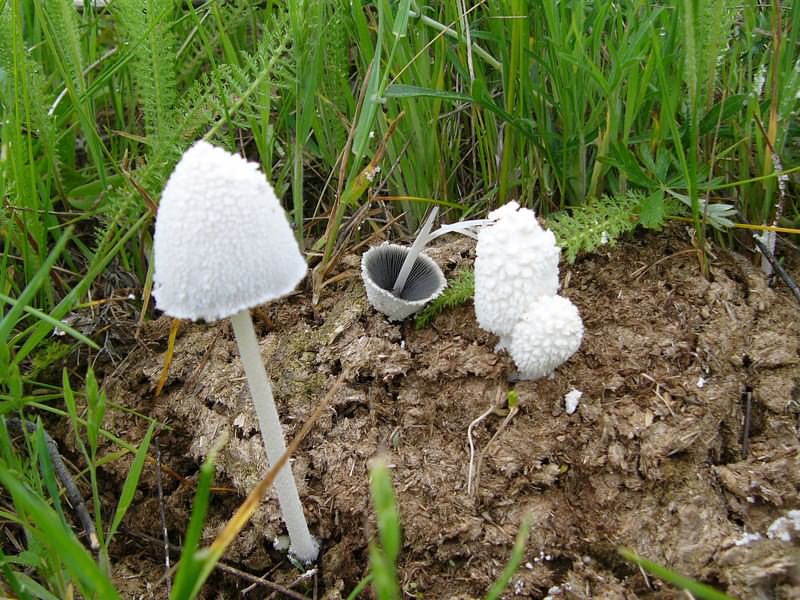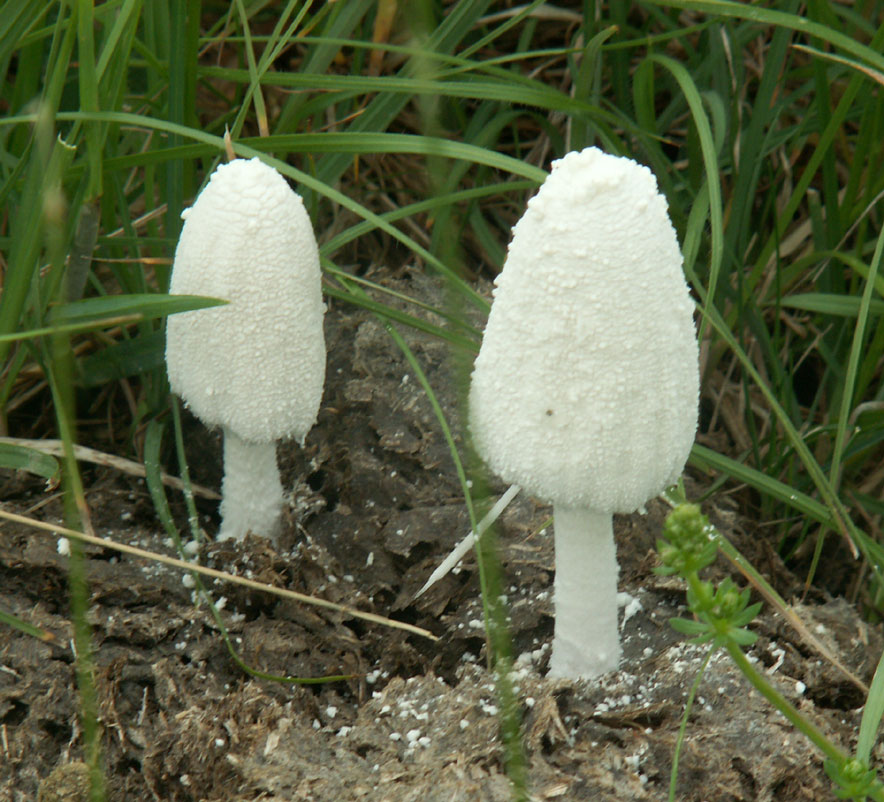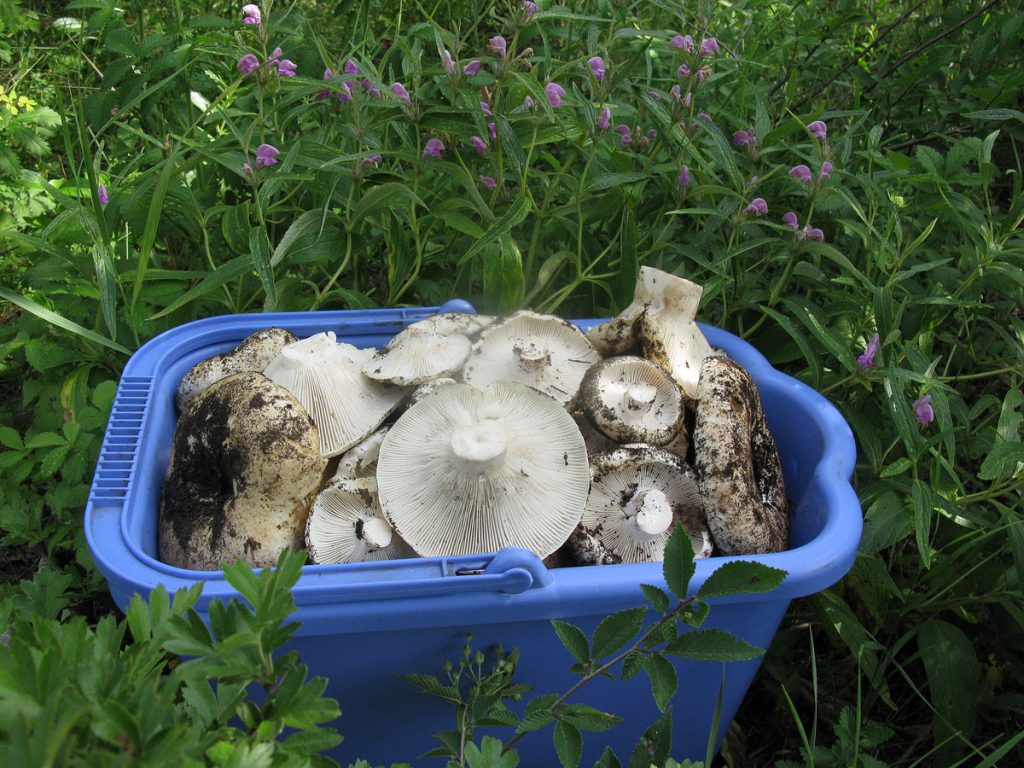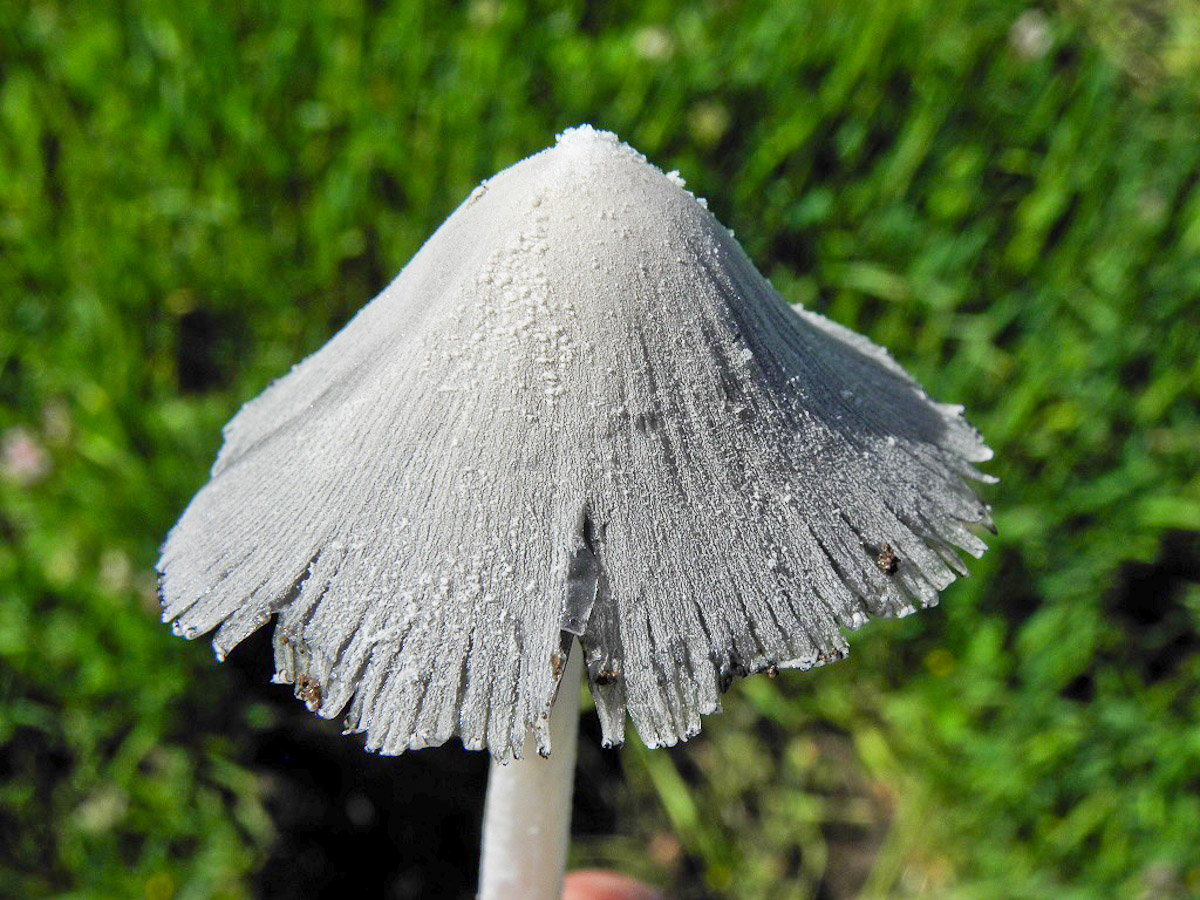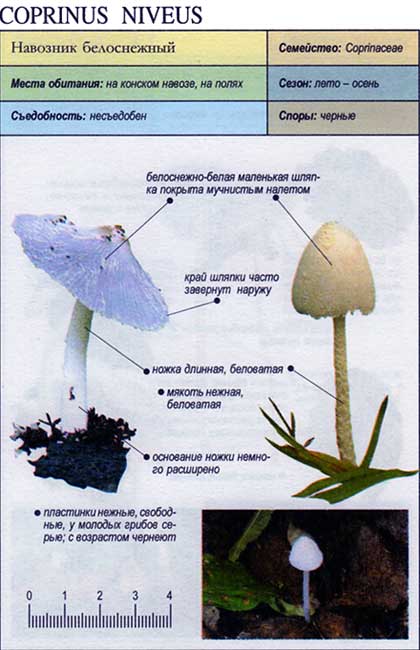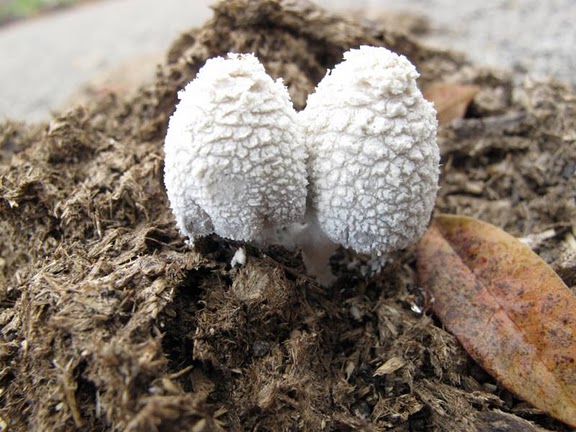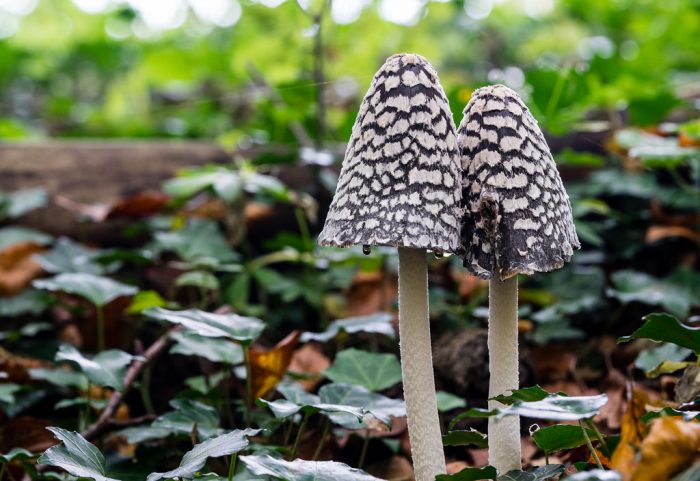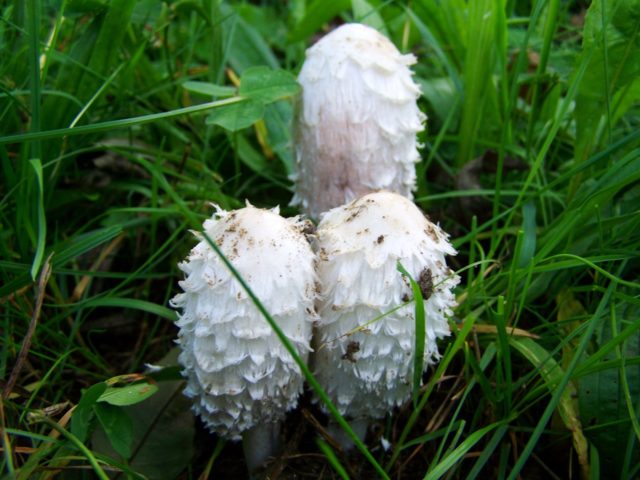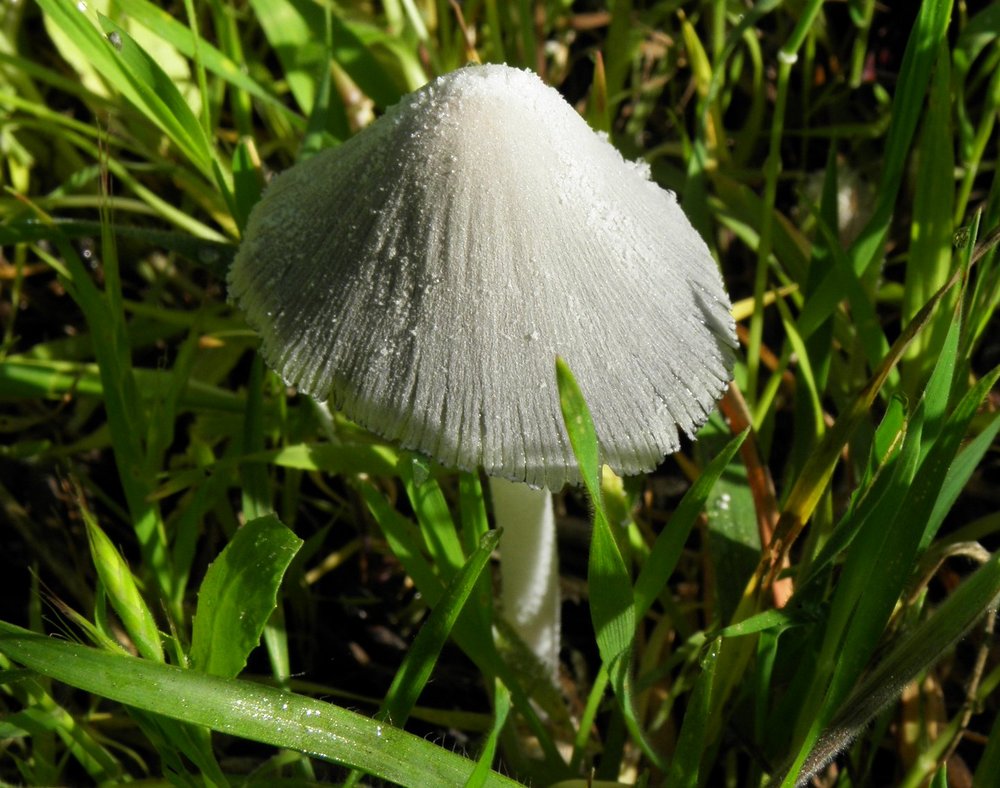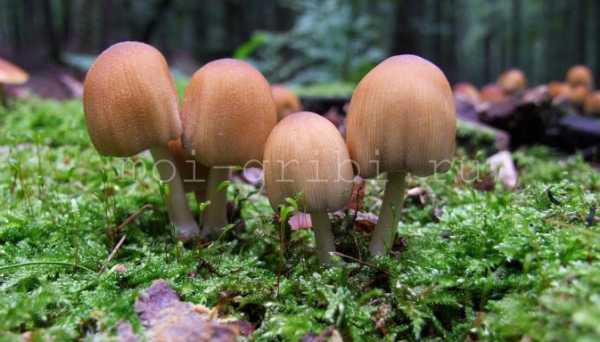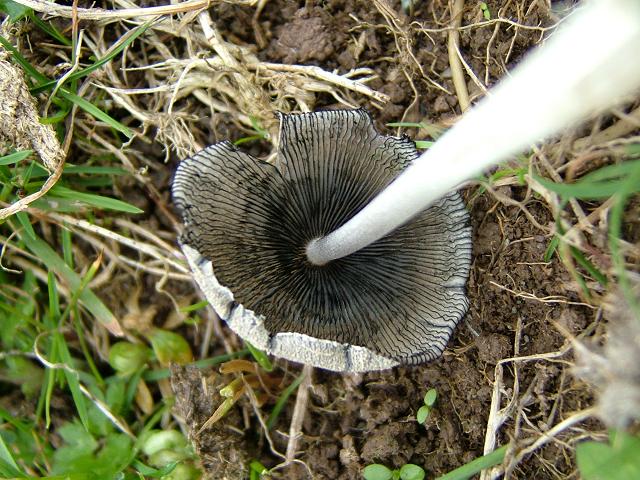White dung beetle (Coprinus comatus)
Other names for the mushroom:Ink mushroom
or
Ink mushroom
Dung beetle (Latin Coprinus comatus) is a mushroom of the genus Dung (Latin Coprinus) of the Dung family.
Hat: Height 5-12 cm, shaggy, white, first spindle-shaped, then bell-shaped, practically does not straighten. There is usually a darker bump in the center of the cap, which, like the captain, is the last to disappear when the cap of the mushroom comes out on the ink. The smell and taste are pleasant. Frequent, free, white, turn pink with age, then turn black and turn into "ink", which is characteristic of almost all dung beetles.
Spore Powder: Black.
Leg: Length up to 15 cm, thickness 1-2 cm, white, hollow, fibrous, relatively thin, with a white movable ring (not always clearly visible).
Distribution: White dung is found from May to autumn, sometimes in enchanting quantities, in fields, vegetable gardens, orchards, lawns, in garbage dumps, dumps, dung heaps, as well as along roads. Occasionally comes across in the forest.
Similar species: White dung (Coprinus comatus) is almost impossible to confuse with anything.
Edible: Excellent mushroom. However, it should be remembered that you can only pick mushrooms that have not yet begun to fulfill their Great Mission - to self-digest, to turn into ink. The plates must be white. True, nowhere is it said what will happen if you eat (eat, as they say in special editions) dung beetle, which has already started the process of autolysis. However, there are hardly any who wish. It is believed that white dung is edible only at a young age, before the staining of the plates begins, no later than two days after it emerged from the soil. It is necessary to process it no later than 1-2 hours after collection, since the autolysis reaction continues even in frozen mushrooms. It is recommended to pre-boil it as conditionally edible, although there are claims that the mushroom is edible even in its raw form. It is also not recommended to mix dung beetles with other mushrooms.
It should also be noted that according to scientific data, garbage saprophytes like dung beetles with special enthusiasm pull all kinds of harmful products of human activity from the soil. Consequently, it is impossible to collect dung beetles in the city, as well as near highways.
By the way, it was previously believed that Coprinus comatus contains substances incompatible with alcohol, and therefore, in a sense, poisonous (although, for that matter, alcohol itself is poisonous, not the mushroom). Now it is quite obvious that this is not the case, although sometimes this old delusion pops up in the literature. Many other dung beetles like Gray (Coprinus atramentarius) or Shimmering (Coprinus micaceus) are advocating a healthy lifestyle, although this is not certain. But the White Dung, fortunately or unfortunately, is deprived of this property. That's for sure.
Notes: I have many childhood memories associated with the dung beetle. In the second class, in the fall, I somehow unexpectedly became a big enthusiast of "city mushrooms", spending whole days in search of dung beetles and champignons. I knew all the yards in my neighborhood, I had a lot of volunteers. They laughed at me, of course, but for some reason they willingly helped.
At home my inclinations were fully supported. Oddly enough, in terms of mushrooms, they completely trusted me even then, and every autumn for several years in a row dung beetles and, less often, champignons appeared on our table. Dung beetles stewed in sour cream, and cheese on top - it's impossible to forget. How I began to collect them and why I stopped - I definitely don't remember, but dung beetles in sour cream ...
Mushroom photo Dung beetle white from questions in recognition:
The dung beetle mushroom has probably been seen by everyone. Outwardly, it looks unattractive - a thin leg and a blackening cap immediately evoke thoughts of its inedibility. But this is fundamentally wrong! This type of mushroom is edible, and in some national cuisines it is even considered a delicacy!
The peculiarity of the dung beetle or koprinus is that it ages very quickly. In just a few hours, a snow-white mushroom turns into an unsightly dark blot
Therefore, it is very important to find and collect it in time.
Before answering the question whether this mushroom is edible or not, it is worth understanding that there are a couple of dozen species of coprinus in nature. And some species are more or less poisonous. Consider those types of dung fungus that are common in our latitudes and can be used in cooking or traditional medicine.
Brief description, characteristics and class of the hallucinogenic mushroom
Amanita muscaria is a representative of the genus Amanita, the Amanita family. Latin name: Amanita strobiliformis. The mushroom has another name: Amanita cone-shaped.
The upper part of the cap is colored white or cream, on top of which there are numerous scaly growths of gray or brown color. Growths are the remnants of the blanket that served as a shell for the fly agaric when it was at a young age. The bedspread is of several types: general and private, the first covers the mushroom completely, while the other protects only the lower surface of the cap. However, when the fungus begins to grow, it breaks open and remains on the stem in the form of a ring and scales that cover the cap. Residual parts are necessary to determine the variety of the fruiting body.
The average diameter of the cap is 20 cm. Initially, it is semicircular, but eventually becomes flat. Smooth around the edges, without scales. The fly agaric hymenophore is presented in the form of numerous plates. This is the name of the lower part of the cap, on which spores are located, intended for further reproduction. When the cap is cut, a pleasant smell is felt.
The stem of the pineal fly agaric grows up to 20 cm, grows in diameter up to 2–3 cm. It is placed deep in the ground, the base has a bulbous thickening. There is a ring on the leg, which disappears with age.
A bit of history
This species was first discovered by local mushroom pickers living near Mount Amon. In 1956, the scientist V.G.Bogoraz became interested in him, he analyzed the effect of the pineal fly agaric on the human body.
Growth area and species
They usually appear in places rich in various organic remains (the name "dung beetle", as you might guess, comes from the word "manure" - one of the collective names for natural fertilizers), found on half-rotten stumps, rotting trees. Dung bearers can be found almost always in the warm season - mushroom pickers collect them from mid-May to late October, most of them in September.
In total, about two and a half dozen species of koprinus are known. Only some of them can be eaten, the rest are considered inedible and may even be poisonous to humans. We will cover four of them:
- Common dung beetle.
- The dung beetle is white.
- Gray dungweed (ink mushroom).
- Flickering dung.
Common dung
The cap of this mushroom bends smoothly and tapers downwards, but with age it opens and becomes like a wide bell. The surface of the caps of young mushrooms is slightly shaggy, covered with white scales; in the elderly it becomes more and more ribbed or wrinkled, the edge of the "bell" bends outward and darkens until it becomes completely black.
The common dung beetle cap has a diameter of up to 3 cm, the leg is very thin and fragile, hollow inside, reaches a height of 8-10 cm, thickens towards the base.
Dung beetle white
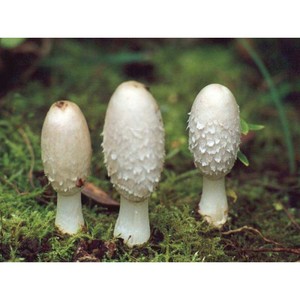 This mushroom is also called "shaggy" dung beetle. Its cap has the same shape as the previous species and is abundantly covered with snow-white glossy scales, slightly silky to the touch. This species is somewhat larger than the common coprinus: its cap reaches 8-10 cm in diameter, and the height of the leg is up to 15 cm.
This mushroom is also called "shaggy" dung beetle. Its cap has the same shape as the previous species and is abundantly covered with snow-white glossy scales, slightly silky to the touch. This species is somewhat larger than the common coprinus: its cap reaches 8-10 cm in diameter, and the height of the leg is up to 15 cm.
Initially, it has a white color (this feature gave the name to the mushroom white dung beetle), and in this form it is suitable for collecting and eating. The flesh of a young white dung beetle is very tender; some amateur mushroom pickers use it raw.With age, the cap of the mushroom gradually darkens, acquires brownish or grayish shades.
Unlike its common counterpart, the white dung beetle grows mainly in families.
Gray, or ink mushroom
 From the very beginning of its appearance, the cap of this mushroom is painted in gray tones, in the middle of it there is a spot of a darker color, surrounded by a lighter centric ring (it disappears in aging mushrooms). The scales on the cap characteristic of coprinuses are much less pronounced than in the previous two species, and have a darker shade than the cap surface itself. The young mushroom has an ovoid shape, later it opens and becomes like a bell, reaching a diameter of about 10 cm, turns black in old age and seems to "melt", emitting a black liquid: the second name of this coprinus is an ink mushroom. The thin leg can reach 20 cm in height.
From the very beginning of its appearance, the cap of this mushroom is painted in gray tones, in the middle of it there is a spot of a darker color, surrounded by a lighter centric ring (it disappears in aging mushrooms). The scales on the cap characteristic of coprinuses are much less pronounced than in the previous two species, and have a darker shade than the cap surface itself. The young mushroom has an ovoid shape, later it opens and becomes like a bell, reaching a diameter of about 10 cm, turns black in old age and seems to "melt", emitting a black liquid: the second name of this coprinus is an ink mushroom. The thin leg can reach 20 cm in height.
Shimmering coprinus
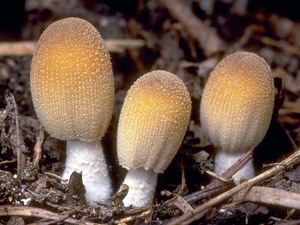 The young mushroom has an egg-shaped cap characteristic of the coprinus, which later opens into a bell. The color is yellowish-brown, darkening towards the center. The scales on the surface are very small, glossy and grainy, and disappear as they mature.
The young mushroom has an egg-shaped cap characteristic of the coprinus, which later opens into a bell. The color is yellowish-brown, darkening towards the center. The scales on the surface are very small, glossy and grainy, and disappear as they mature.
This is one of the smallest coprinuses, reaching only 3-4 cm in diameter, with a fragile thin (no thicker than 0.5 cm) leg. The best conditions for its growth are plant fertilizers: rotten tree trunks, deciduous humus. It appears not only in forests, but also in city dumps, in compost heaps (the latter, for obvious reasons, we do not recommend eating).
The white flesh of a young mushroom has a sour taste.
Interesting Facts
Dissolving, the mushrooms form a liquid stain or dark gruel. It used to be used instead of ink. Hence the second common name for dung beetles is ink.
- The process of decomposition of the dung beetle cap does not occur under the influence of external factors, but due to the enzymatic reaction of the fungus itself, autolysis.
- It is not for nothing that the dunghill is called the ink mushroom - before it was used to make ink and ink.
At one time, ink was made from the black liquid into which overripe dung beetles turn to draw up especially important state documents. The fact that the document is genuine was evidenced by the spores of fungi, clearly visible if the signatures are examined under a microscope.
Thus, dung beetle is not a very famous mushroom, but it is quite worthy of the honor to be in the basket, on the table, and even in a medical recipe. Its valuable properties are very diverse.
The very name of the mushroom - ink - is no coincidence. It was from it that people learned to get ink back in the old days. Moreover, they were not available to everyone due to their price and quality. They were used only for important documents and bills of exchange. The use of mushroom ink protected documents from forgery due to the different patterns of disputes on the papers. At the same time, for comparison, it was necessary to have a sample of the ink itself.
The "inkiness" of mushrooms is explained by the process of maturation of spores. More often than not, they ripen, dry out and are carried by the wind. In the dung beetle, another process takes place - autolysis.
It lies in the fact that as the mushroom matures, it begins to self-digest. As a result of such aging, a dark puddle with spores forms at the site of the fruiting body. If it rains, it will wash away these spores and spread them around. This "digested" liquid was used in the manufacture of ink.
Dung beetles gray and sparkling
Gray dung beetle (Coprinus atramentarius) is a well-known but little favorite in the villages of Russia. He is little loved for a simple reason - it causes poisoning (small, but unpleasant), if combined with alcohol. Therefore, in central Russia, it is called the mother-in-law mushroom. He also has other names - coprinus (Coprinus atramentarius), ink mushroom, blagusa, stove, sozhok.
The generic name of these mushrooms - koprinus - comes from the Greek word copros, which means manure.Hence the second very common name of this genus - dung beetles. Mushrooms that settle on manure are called coprophiles. Many koprinus also belong to this ecological group of fungi. In total, the genus includes about two hundred species. They are cosmopolitan and are found almost all over the globe. Species of this genus settle on the manure of herbivores, well-fertilized soil, on decaying stumps and other plant debris.
Therefore, they are often found in gardens, vegetable gardens, on garbage heaps, near livestock farms, in meadows where livestock graze. These mushrooms also settle in cities (they are abundant in parks, on the lawns of public gardens). They are also found in the forest, especially on the edges, where cattle enter when grazing. Smaller species (eg Coprinus dissiminatus) abundantly cover half-decayed tree stumps.
Among the mushrooms, they are ephemeral. They grow and ripen so quickly that no mushroom can compete with them. The life of small species is extremely short. Seen in the evening, having lived only one night, they disappear by morning. Larger species such as white dung beetle (Coprinus comatus) develop slightly longer. But even in him, already 48 hours after the formation of the fruiting body, the cap turns black and spreads into a black liquid mass containing numerous spores. This phenomenon is called autolysis.
Hat. Diameter 5-10 cm, in young mushrooms ovoid, later bell-shaped, quickly opens. The edges of the cap are ribbed; when ripe, they break and spread in the form of ink. The color is from light gray to brownish, the tone is darker in the center. The cap of the gray dung beetle mushroom is sprinkled with glossy scales. The plates are free, at first grayish, flaky-pubescent, when the mushroom ripens, they quickly turn black. The pulp is light, without a special smell, the taste is sweetish.
Leg. Height 8-20 cm, diameter 1-2 cm, cylindrical, naked, with whitish or grayish flesh, with a silky sheen.
Spore powder. Black.
Habitat. In gardens, parks, along old forest roads, by the stumps of deciduous trees. It grows in bunches.
Season. From April to autumn. The authors found the mushroom even in March.
Similarity. According to the description, this dung beetle mushroom is similar to other species of coprinus, in particular, it is similar to the magpie dung beetle, or woodpecker (Coprinus picaceus), which has a variegated black and white color. This mushroom is found in the autumn in the forest and is considered inedible or slightly poisonous.
Use. It is tasty fried, but only young specimens can be used for food. It is necessary to avoid the use of alcoholic beverages at the same time as mushrooms, as well as the day before and during the day after eating the mushrooms. The dung contains a substance similar to antabuse used for the treatment of alcoholism, which prevents the oxidation of alcohol. Previously, gray dung beetle was used in the manufacture of ink used for writing especially important papers, since the spores of the fungus formed a unique pattern that could not be faked.
Medicinal properties. There are reports of Czech scientists about the use of dung beetle in the treatment of alcoholism.
Sparkling dung beetle, red (Coprinus micaceus) has a cap 2–4.5 cm in diameter and 2–3.5 cm high. The cap is bell-shaped or cone-shaped, yellow-brown, darker in the center, radially ribbed, folded, blurs when ripe. On young specimens, a light granular bloom is clearly visible, which disappears with age. The plates are whitish at first, then yellowish-brown, eventually turn black. Leg 3-11 × 0.3-0.7 cm, cylindrical, hollow, smooth, whitish. The pulp is pale yellow.
Growth. Grows in forests, gardens, parks on decaying wood or humus soil.
Fruiting. Forms fruiting bodies in May - November.
Usage. Consumed fresh at a young age, with alcohol it can cause poisoning.
Here you can see photos of dung beetles, the description of which is given on this page:
Dung beetle in the photo
Magpie dung in the photo
Red dung in the photo
Evaluation of taste, medicinal properties, benefits and possible harm
Numerous studies have confirmed that this mushroom contains a special substance that has a destructive effect on the development of malignant tumors. There is evidence that treatment with coprinus helped to stop the development of aggressive sarcoma.
Having learned about all the beneficial properties of this amazing mushroom, you are guaranteed to stop being dismissive of it.
What are the useful functions of the coprinus mushrooms:
- contribute to the normalization of blood pressure;
- have a pronounced anti-inflammatory effect;
- due to the content of a natural antibiotic, they have a bactericidal effect;
- blocking the growth of tumor cells;
- activation of digestion;
- cleansing the body of radicals and toxins.
The mushroom has practically no contraindications to the use.
However, it should be used with caution by people with severe heart disease.
Ink mushroom, like most other dung beetles, is edible only while young. Today it is consumed boiled, fried and pickled. The hats can also be dried and used as spices, but until recently in Russia, these mushrooms were considered a toadstool.
Abroad, dung beetles are highly valued, and white dung beetles are even considered a delicacy.
IMPORTANT: You should not combine different types of dung beetles in one dish, since, although they are completely edible separately, in combination they can cause poisoning!
Common dung beetles are used after boiling. Then they do whatever they like - they can be fried, stewed, put in soup, and also pickled.
REFERENCE: common dung beetles can be frozen for future use, but only boiled. If the mushrooms are frozen fresh, after thawing, an autolysis reaction will occur in them, and only an unappetizing slurry will remain of them.
Proteins - 3.09 g (46%)
Fats - 0.4 g (5%)
Carbohydrates - 3, 26 g (49%)
· Calorie content - 16–20 kcal
Up to 90% of the mass of the fruiting body is water.
TIP: Frying mushrooms produces a lot of water. It is better not to evaporate it, since the aroma is lost during the long heat treatment of the mushrooms, but to drain and add, for example, to the broth for the soup.
- promotes digestion, stimulates appetite;
- lowers blood pressure;
- antibiotic;
- lowers sugar levels;
- antineoplastic;
- hemostatic;
- bactericidal;
- anti-inflammatory;
- antioxidant.
Description of snow-white dung beetle
The diameter of the snow-white dung beetle cap is small - 1-3 centimeters. At first, the shape of the cap is elongated-ovate, with age it becomes bell-shaped or conical, and even later it reaches flat with the edges raised upward. The hat is covered with a pure white skin. The cap has an abundant powdery coating, which is the remainder of the bedspread. This plaque is washed away by the rain.

The plates are frequent, free. The color of the plates is first gray, then it turns black, and over time they completely liquefy. The spores are flattened ellipsoidal, their shape is hexagonal, and the surface is smooth. Black spore powder.
The flesh of the cap is very thin, its color is light. A snow-white dung beetle has an average length of 5-8 centimeters, and its diameter is 1-3 millimeters. At the base, it is swollen. The surface of the leg is white, mealy.

Places of growth and fruiting times of snow-white dung beetles
Snow-white dung grows on horse manure, can be found next to manure in wet grassy places. Fruiting occurs from summer to autumn.
Evaluation of the snow-white dung beetle
This mushroom is inedible.

Scattered dung is an inedible mushroom. The caps of these mushrooms are small, they have very little pulp, the diameter does not exceed 1.5 centimeters. The shape of the cap is bell-shaped, its surface is folded. The color of young mushrooms is light cream, but they quickly turn gray. During decomposition, dung beetles are scattered, unlike their counterparts, practically do not emit dark liquid... The leg is no more than 3 centimeters high, it is very fragile, and its color is white-gray.
Scattered dung beetles grow from late spring to mid-autumn. They can be found on rotting wood. Most often they congregate in large colonies, covering evenly large areas. Separately, these mushrooms were not seen.

Flickering dung is a conditionally edible mushroom. The shape of its cap is ovoid, and then it becomes bell-shaped. It is almost never fully disclosed. Its diameter reaches 4 centimeters. The surface of the cap is covered with a large number of shiny scales, but they are easily washed off by rain. The leg is long enough, hollow, white, silky at the bottom.
Dung beetles that shimmer from spring to autumn bear fruit. These mushrooms settle on decaying wood. Most often they are found in large clusters. Flickering dung beetles most likely do not like conifers. Shimmery dung are edible at a young age. And these dung beetles should not be taken with alcohol. They, like gray dung beetles, contain substances that are incompatible with alcohol. Mild poisoning can occur when these mushrooms are consumed with alcohol.

Description
Ink mushroom - he is gray dung or ink dung. Scientific name Coprinopsis atramentaria or Coprinopsis atramentarius. Belongs to the genus Dung or Koprinus (Coprinus) of the family Dung or Psathyrellaceae. Popular English name - Alcohol inky cap - alcoholic ink cap.
The cap is 5 to 10 cm in diameter, 4 to 10 cm high. In a young mushroom, it is at first ovoid, wrinkled, and then rapidly opening into a wide-bell-shaped, with cracking edges. In adulthood, it turns up. The color of the cap is whitish-gray, gray or dirty brown. The middle is darker than the edges. Its surface (especially the center) is covered with small darkish scales.
The hymenophore (the lower part of the cap, bearing a thin spore-bearing layer of hymenium on the surface) is white, lamellar. The plates are wide, frequent, and uniform in length. On the cut - flaky.
Its pulp is light, very fragile, but darkens quickly at the site of a cut or break. It has a weak, pleasant smell and sweetish taste.
The leg grows in height by about 10–20 centimeters. In diameter - from 1 to 3 centimeters. White, slightly brownish at the base with a thickening, smooth. It has a cylindrical shape, most often curved and hollow inside.
A bit of history
For the first time in history, dung beetles were described by Danish scientists Otto Frederik Müller (1730 - 1784). And at the end of the eighteenth century, mycologist Christian Heinrich Persons from the Netherlands transferred the ink mushroom to a new family of lamellar or agaric (Agaricaceae).
The dung beetle cap resembles a bell in shape, the pulp is fibrous. The top is abundantly covered with scales, resembling flakes. Thin plates change color from white to black with age.
The thin leg is very fragile, hollow inside.
Thin-bodied, the flesh is practically absent. Black oval spores. It grows extremely quickly, in a matter of hours, and in some cases the full ripening cycle is no more than one hour.
Ripening, the cap dissolves (autolysis), a gruel or an ink-colored spot in the form of a ring forms in place of the fungus. Autolysis continues after harvesting, so it is impossible to store fresh mushrooms, even frozen. Immediate heat treatment is required.
Edible only while young, identified by white plates. Therefore, the dung beetle belongs to conditionally edible mushrooms. If the plates begin to turn yellow or pink, the mushroom is no longer suitable.
Saprotroph, i.e. helps to decompose organic residues.
Loves soil rich in organic remains, fertilizers, found on rotting trees, stumps. Collection time from May to October.
Hat
The flesh of the cap is thin, the cap is fibrous to the touch, covered with large white scales.The cap of a young mushroom is conical, almost fusiform, with edges closed at the stem. As the mushroom grows, the cap opens a little, taking the shape of a bell, very rarely - it opens to the state of an umbrella. There is a gray or brownish tubercle in the center of the cap. The pulp of a young mushroom is tender, white, with a weak mushroom aroma and unexpressed taste.
Spore-bearing layer
White, rather thin, covered with velvety scales. The inside is hollow, the flesh is also white, the old mushroom is creamy, without any special smell or taste. In thickness it reaches one and a half centimeters, in height up to 15-17 centimeters. There is an easily movable ring on the leg, however, as it grows, it quickly disappears. At the base of the leg there is a characteristic “sac” (the so-called vagina)
Reproduction
A distinctive feature of all coprinus is their unique way of reproduction. Due to the fact that the lower plates of the fungus, where the spores are contained, are very closely adjacent to each other, the coprinus cannot easily disperse them in the wind.
And then it turns on a special mechanism called autolysis. The fungus produces special enzymes that begin to actively digest the mushroom cap. That is, the mushroom actually eats itself.
As a result of this process, spores are released, and the cap turns into a viscous black liquid that flows from the stem and spreads over the surface of the earth.
An amazing way of self-sacrifice on the part of parents for the sake of procreation of their own kind!
Hairy
Other names: fluffy dung beetle, uplifted dung beetle.
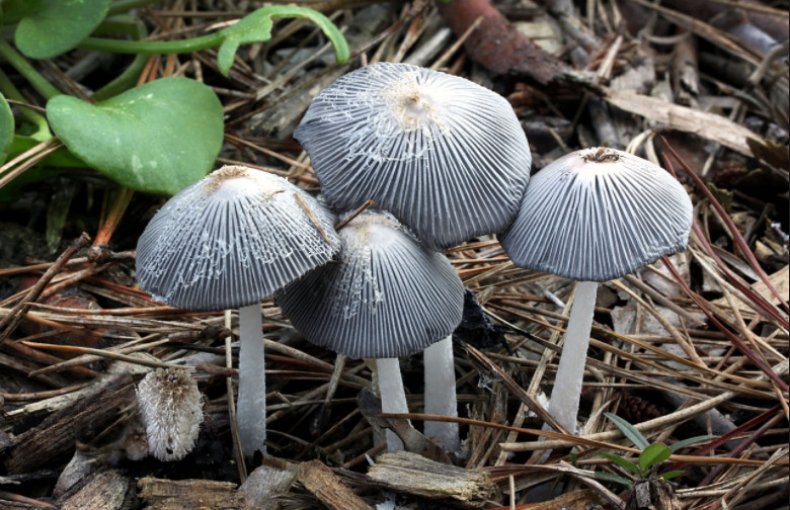 Coprinopsis lagopus
Coprinopsis lagopus
Appearance. The hat resembles a spindle in shape, the diameter is 1-2 cm, the length is from 2 to 4 cm. Young mushrooms enter the stage of maturity after two days, after which the hat opens. In mature representatives of the species, it has the shape of a bell. The skin is dark olive colored. The surface is dotted with white flakes, so the mushroom appears pure white from a distance. The pulp is white, very thin, breaks at the slightest touch. The leg is 5 to 8 cm long, thin, can bend during growth. Painted white. There are many snow-white scales on the surface. The plates are narrow, loose, gray at the initial stage, then turn black and collapse.
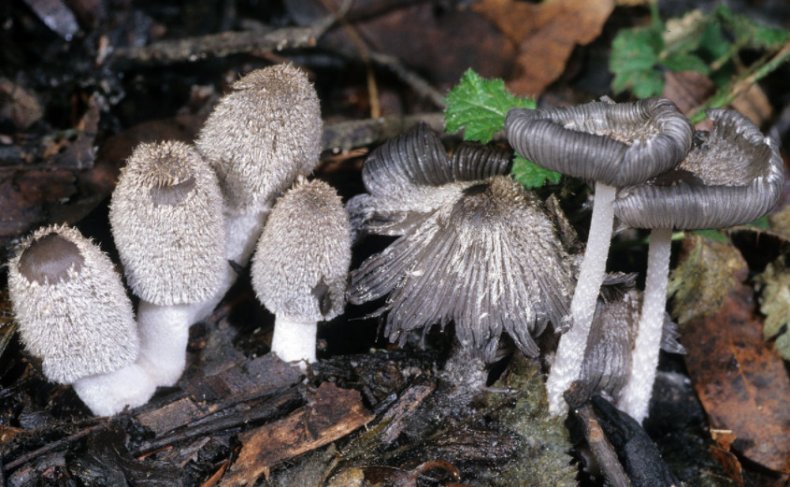
Where it grows. It is found both in pastures, where it is engaged in the processing of manure, and in old forest plantations. The fungus can feed on rotten wood, as well as rotting fallen leaves.
Often there is a problem with the identification of the fungus, since the fruiting body forms and decomposes in a few days, so it is very difficult to find a young mushroom.
Did you know? Many mushrooms have medicinal properties. For example, the peel of raincoat mushrooms can be used as an adhesive plaster, since its reverse side is completely sterile and also exhibits bactericidal properties.
Seasonality and edibility. The fluffy mushroom bears fruit during mass grazing. As soon as animal waste disappears, fruiting bodies stop forming. The estimated growth period is summer-autumn.
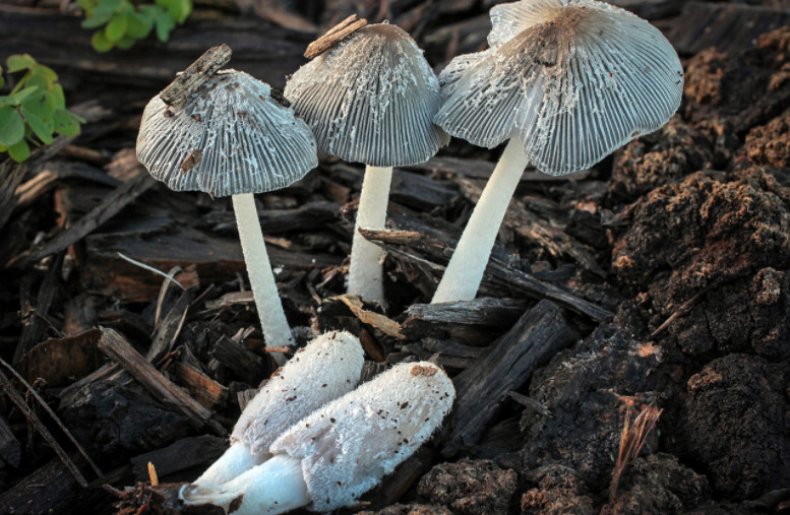
Hairy dung beetle is not eaten. The fungus is not classified as poisonous, however, given the short decomposition period, even young specimens can be poisoned, so it is better not to risk it.
Interesting to read: Edible mushrooms of Ukraine: TOP-15
Description
Dung beetle gets its name from the fact that it grows on nutrient-rich substrates and soils, on decaying plant and wood debris. The Latin name is Coprinus. It belongs to the mushroom genus. Most species are poisonous. Dung beetle is also called ink fungus, due to the liquid formed during decay. It is used in the manufacture of ink.
Koprinus can be easily distinguished from other mushrooms: bell-shaped cap, hollow elongated stem, grayish-white color. Outwardly, the dung beetle is inconspicuous. An ignorant mushroom picker may not pay attention to him. However, all over the world, some types of coprinus are considered gourmet.But the anti-alcohol effect remains the main property. Dung beetle is recognized not only among culinary specialists, but also among doctors.
Consultation with a specialist is required before taking ink mushroom for alcoholism.
The effectiveness of the dung beetle is confirmed by former alcoholics.
White
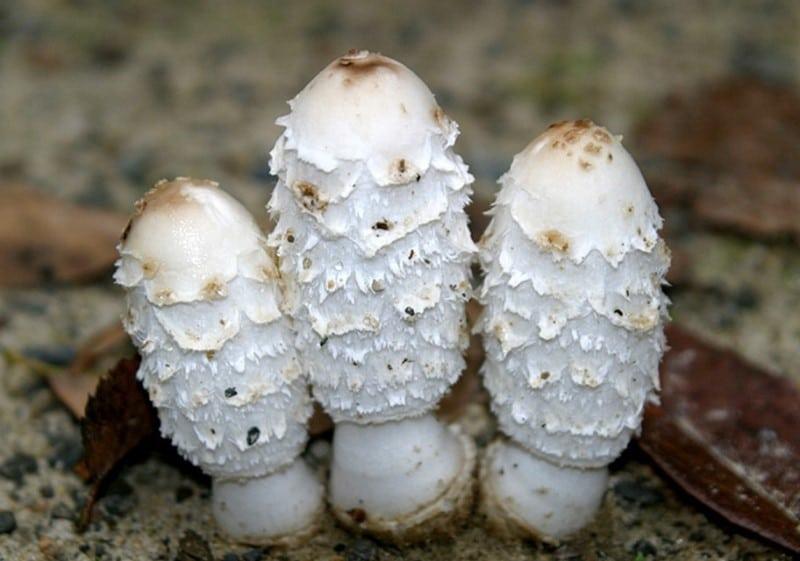


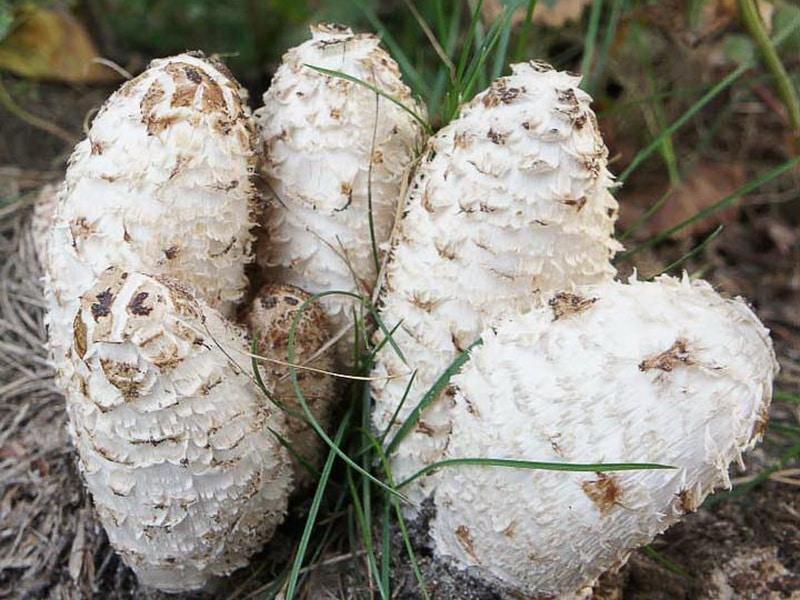

White koprinus is found in every courtyard in central Russia. Mushroom pickers can collect it both in front of their own house and in a public park. It is he who is considered delicious. This mushroom is used in haute cuisine. White dung beetle can only be eaten at a young age. It is incompatible with alcohol and causes poisoning symptoms. White coprinus has less anti-alcoholic effect than its counterparts. It is used for long-term treatment. This method is not used when changing the color of the plates of the mushroom cap.
Gray
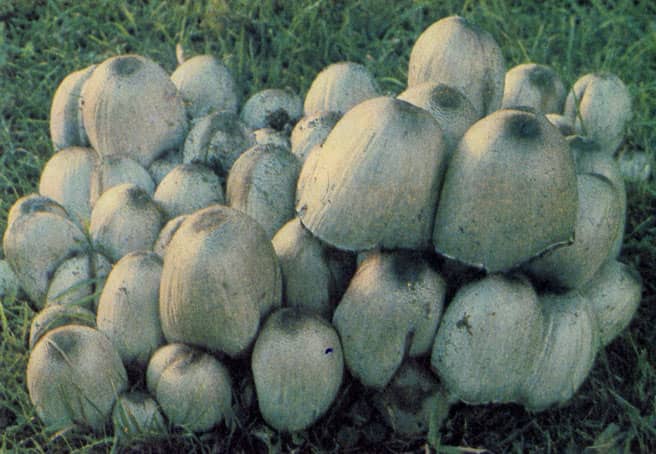

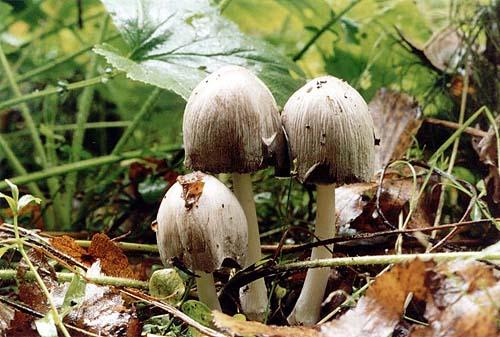

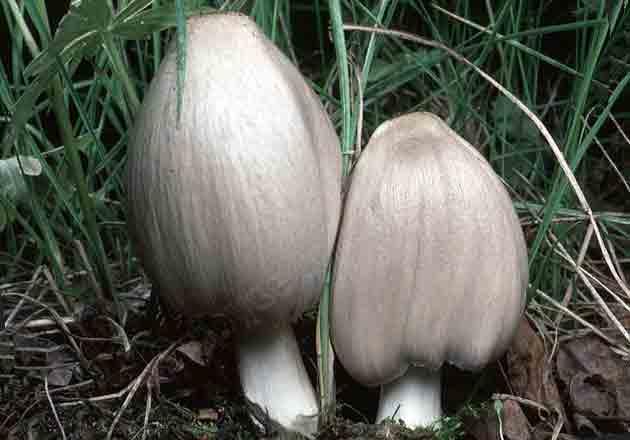
The gray ink fungus contains the highest concentration of sulfides and protoxins. These are the main operating elements. Gray dung beetle is distinguished by a gray cap, small size and scales. Over time, the mushroom darkens and loses its healing properties. It is the gray koprinus that is popular in the fight against drunkenness in traditional medicine.
Scattered
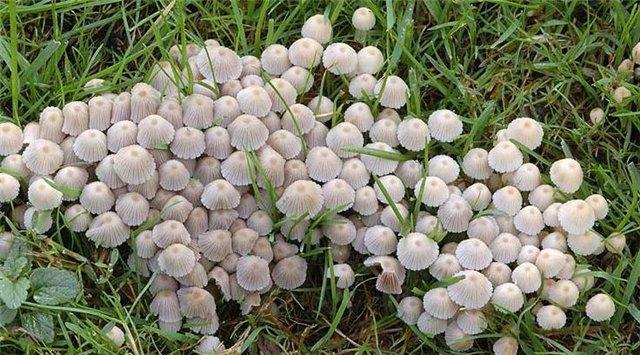




Scattered dung beetle grows in groups. It has the smallest size among other coprinus. The color does not change over time. This type of mushroom is inedible. Their colonies cover large areas of decaying wood. Scattered dung beetle causes intoxication of the body when consumed with alcohol. However, white or gray coprinus are more effective.


